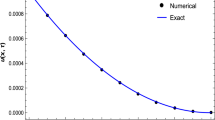Abstract
Systems of ordinary differential equations obtained by using splitting-up techniques in some air pollution models and a pseudospectral (Fourier) discretization of the first-order space derivatives are considered. The application of a fairly general class of predictor-corrector (PC) schemes in the time-discretization process is discussed. Several corrections with different corrector formulae are carried out in thesePC schemes. The classicalDahlquist theory valid for the case when the stepsize is constant is preserved (under very mild restrictions on the stepsize) when suchPC schemes are used as variable stepsize variable formula methods (VSVFM's). This fact is exploited by allowing the stepsize to follow the variation of a certain norm of the wind velocity vector in aVSVFM based on specially constructedPC schemes with large intervals of absolute stability on the imaginary axis. A device that attempts to check both the accuracy and the stability in the course of the integration process has been developed. The code based on the application of thisVSVFM in the time-integration part of the treatment of both 2-dimensional and 3-dimensional models has been tested by using meteorological data prepared at stations located in practically all European countries. The numerical results indicate thatPC schemes with several correctors can successfully be used for the class of problems under consideration. The main reason for this success is the special nature of the computational cost per time-step (due to the splitting approach used). Some short remarks on the possibility of extending the results for large systems ofODE's arising in the treatment of other classes of problems are made.
Similar content being viewed by others
References
A. K. Bagrinowskii and S. K. Godunov,Difference schemes for multidimensional models. Dokl. Akad. Nauk SSSR, 115 (1975), 431–434.
G. Dahlquist,Convergence and stability in the numerical integration of ordinary differential equations. Math. Scand., 4 (1956), 33–53
G. Dahlquist,Stability and error bounds in the numerical integration of ordinary differential equations. Trans. Roy. Inst. Techn., No. 130. Stockholm, 1959.
G. Dahlquist,A special stability problem for linear multistep methods. BIT, 3 (1963), 27–43.
G. Dahlquist,Error analysis for a class of methods for stiff non-linear initial value problems. In:Numerical Analysis Dundee 1975 (Lecture Notes in Mathematics, Vol. No. 506), pp. 60–74. Springer, Berlin, 1976.
G. Dahlquist,On the relation of G-stability to other concepts for linear multistep methods. In:Topics in Numerical Analysis III (J. H. Miller, ed.), pp. 67–80. Academic Press, London-New York, 1977.
G. Dahlquist,G-stability is equivalent to A-stability. BIT, 18 (1978), 384–401.
R. Fletcher,FORTRAN subroutines for minimization by quasi-Newton methods. Report No. R7125, A.E.R.E., Harwell, England, 1972.
C. W. Gear and D. S. Watanabe,Stability and convergence of variable multistep methods. SIAM J. Numer. Anal., 11 (1974), 1044–1058.
R. D. Grigorieff,Zur Stabilität von Mehrschrittverfahren auf nichtäquidistanten Gitter. In:Numerical Methods for Solving Initial Value Problems, Proceedings, Oberwolfach, 28.6–4.7.1981 (G. Dahlquist and R. Jeltsch, eds.). Bericht Nr. 9. Institut für Geometrie und praktische Mathematik, Rheinisch-Westfälische Technische Hochschule, Aachen, Federal Republic of Germany, August 1981.
R. D. Grigorieff,Stabilität von Mehrschrittverfahren auf variablen Gitern. Preprint Reihe Mathematik Nr. 89. Technische Universität Berlin, Berlin, 1981.
A. C. Hindmarsh,LSODE and LSODI, two new initial value ordinary differential equation solvers. ACM SIGNUM Newsletter, 15 (1980) 10–11.
R. Jeltsch and O. Nevanlinna,Stability of explicit time discretizations for solving initial value problems. Numer. Math., 37 (1981), 61–91.
R. Jeltsch and O. Nevanlinna,Stability and accuracy of time-discretizations for initial value problems. Numer. Math., 40 (1982), 245–261.
H. O. Kreiss and J. Oliger,Comparison of accurate methods for integration of hyperbolic equations. Tellus, 24 (1972), 195–215.
F. T. Krogh,VODQ/SVDQ/DVDQ — variable order integrators for the numerical solution of ordinary differential equations. Report. Jet Propulsion Laboratory, Pasadena, California, USA, 1969.
J. D. Lambert,Computational Methods in Ordinary Differential Equations. Wiley, London, 1973.
R. März,Variable multistep methods. Preprint Nr. 7 (Neue Folge). Sektion Mathematik, Humboldt-Universität zu Berlin, 1086 Berlin, Unter den Linden 6, PSF 1297, DDR, 1981.
S. A. Orszag,Numercial simulation of incompressible flows within simple boundaries: accuracy. J. Fluid Mech., 49 (1971), 75–112.
L. F. Shampine and M. K. Gordon,Computer Solution of Ordinary Differential Equations: The Initial Value Problem. Freeman, San Francisco, California, USA, 1975.
R. D. Skeel and L. W. Jackson,The stability of variable-stepsize Nordsieck methods. SIAM J. Numer. Anal., 20 (1983), 840–853.
H. J. Stetter,Analysis of Discretization Methods for Ordinary Differential Equations. Springer, Berlin, 1973.
N. N. Yanenko, The Method of Fractional Steps. Springer, Berlin, 1971.
Z. Zlatev,Stability properties of variable stepsize variable formula methods. Numer. Math., 31 (1978), 175–182.
Z. Zlatev,Zero-stability properties of the three-dimensional variable stepsize variable formula methods. Numer. Math., 37 (1981), 157–166.
Z. Zlatev,Consistency and convergence of general linear multistep variable stepsize variable formula methods. Computing, 31 (1983), 47–67.
Z. Zlatev,Variable stepsize variable formula methods based on predictor-corrector schemes. Report No. 261. Danish Center for Applied Mathematics and Mechanics, Technical University of Denmark, Lyngby, Denmark, 1983.
Z. Zlatev, R. Berkowicz and L. P. Prahm,Stability restrictions on time-stepsize for numerical integration of first-order partial differential equations. J. Comput. Phys., 51 (1983), 1–27.
Z. Zlatev, R. Berkowicz and L. P. Prahm,Implementation of a variable stepsize variable formula method in the time-integration part of a code for treatment of long-range transport of air pollutants. J. Comput. Phys., 55 (1984), 278–301.
Z. Zlatev, R. Berkowicz and L. P. Prahm,Package ADM for studying long-range transport of air pollutants in the atmosphere. In:PDE Software: Modules, Interfaces and Systems (B. Engquist and T. Smedsaas, eds.). North Holland, Amsterdam, 1984; to appear.
Author information
Authors and Affiliations
Additional information
Dedicated to Germund Dahlquist, on the occasion of his 60th birthday.
Rights and permissions
About this article
Cite this article
Zlatev, Z. Application of predictor-corrector schemes with several correctors in solving air pollution problems. BIT 24, 700–715 (1984). https://doi.org/10.1007/BF01934925
Received:
Revised:
Issue Date:
DOI: https://doi.org/10.1007/BF01934925




